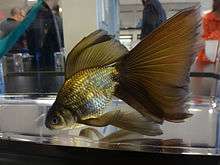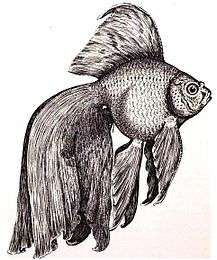Veiltail
 Philadelphia Veiltail Goldfish English Veiltail Goldfish |
|---|
| United States |
| Type |
| Veiltailed |
| Breed standards |
| BAS |

The veiltail is a type of goldfish known for its extra-long, flowing double tail and high sail-like dorsal fin.[1][2]
Description
The veiltail has a modified deep-and-round ryukin-shaped body, though without the dorsal 'hump' characteristic of ryukins. The hallmark of the breed is its lengthy and graceful double tail which is square-edged and without any forking or indentation between the lobes.
It also has a high, prominent and well-developed dorsal fin. The anal fins are paired and are quite well developed as well. The term 'veiltail' is commonly and erroneously applied to any goldfish displaying a long caudal, but true veiltails must have all the characteristics described above. Veiltails are available in many colors and may have either metallic or nacreous scales. They can grow from 8 to 12 inches (20 to 30 cm). They are not good swimmers but can be kept with other fancy goldfish. Veiltails will not accept temperatures below 55 °F (13 °C).[3]
History and origins


The veiltail, a name coined by William T. Innes, originated in the United States in the 1890s when Franklin Barrett of Philadelphia crossed a Japanese-bred fringetail ryukin to a telescope eye goldfish that exhibited a short, square-edged caudal. According to William Seale[4] this fringetail was one of many imported by the Wisconsin State Fish Commission for the World's Fair. However, these fish became sick with fungus and were not shown in the 1893 fair. Mr. Seale saved 5 or 6 of these fish and returned home to Philadelphia with them. Mr. Seale then sold one of these fish to Franklin Barrett for $15 and this was the fish Barrett used to cross to a short but square tailed telescope eye goldfish. The telescope eye goldfish used for this cross were obtained as imports by John Cugley of Philadelphia. This resulted in a strain of fish soon to be known throughout the world as Philadelphia veiltails.[1][2][5] Although some have suggested that Philadelphia Veiltails died out in America,[6] a man named Al Thomma was able to obtain stock from a John (Andy) W. Anderson of Philadelphia who possessed fish from the original Barrett line.[7] Mr. Anderson worked for Innes Publishing as advertising editor and publisher of The Aquarium Magazine. Through the work of Al Thomma and Al Foster[8] we still have the Philadelphia Veiltail today.
Variants

Apart from those bred and developed in the United States, there are now also Chinese and English strains. They can also occur with normal or telescope-eyes.[1][2]
Special care
The long and trailing tail of the veiltail is delicate and can be easily damaged. Veiltails are also susceptible to low water temperatures. Telescope-eyed veiltails have difficulty competing for food with more active goldfish.[1][2]
References
- 1 2 3 4 Andrews, Chris. An Interpet Guide to Fancy Goldfish, Interpet Publishing, 2002. - ISBN 1-902389-64-6
- 1 2 3 4 Johnson, Dr. Erik L., D.V.M. and Richard E. Hess. Fancy Goldfish: A Complete Guide to Care and Collecting, Weatherhill, Shambala Publications, Inc., 2006. - ISBN 0-8348-0448-4
- ↑ Free Information Keeping Veiltail Goldfish
- ↑ "The Aquarium" magazine. March 1968.
- ↑ Aquarium Magazine, Goldfish Society of America, March 1968, p. 55.
- ↑ "Spike's Goldfish Guide" by Peter J. Ponzio. Mid-Atlantic Koi Club. 2007
- ↑ "The Goldfish Report" of the Goldfish Society of America March/April 2003.
- ↑ "The Goldfish Report" of the Goldfish Society of America July/August 2004